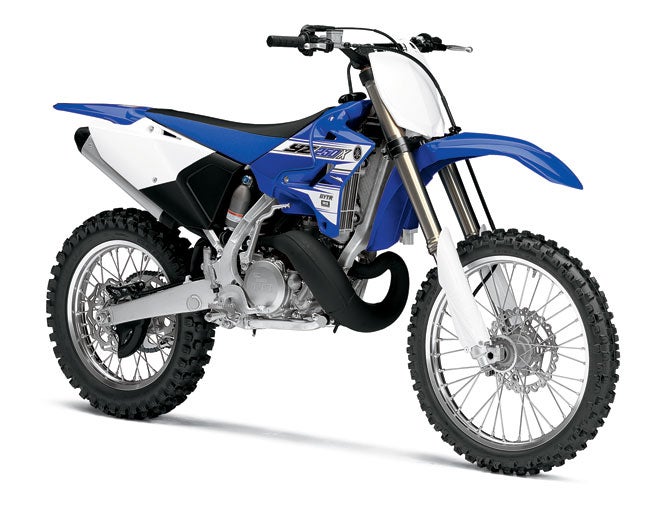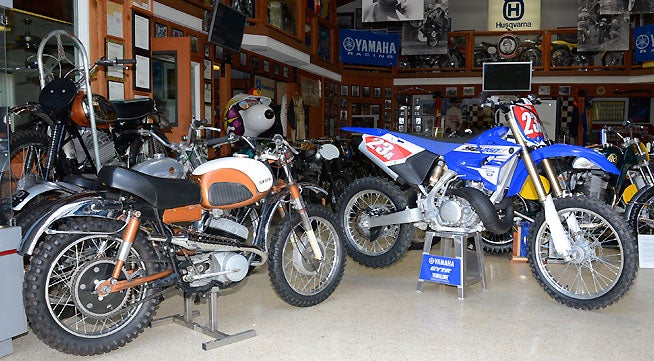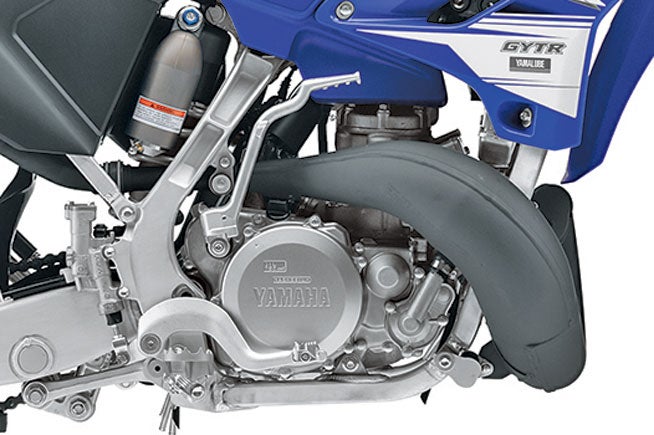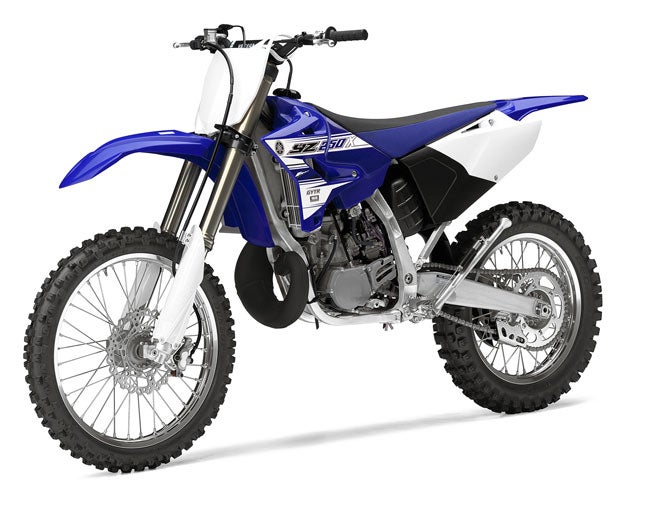Yamaha re-enters the two-stroke off-road racing market with the all-new YZ250X.

When Yamaha unveiled its all-new 2016 YZ250X two-stroke off-road racer to the American press corps last week at Tom White’s Early Years of Motocross museum in Southern California, it came as a bit of a surprise.
After all, the bike hiding under the sheet wasn’t what many in attendance were expecting. With last year’s YZ250F four-stroke-based YZ250FX cross country machine being such a hit—Yamaha claims that it was the best-selling 250cc four-stroke off-road racer on the market last year—a YZ450F-based version in FX trim seemed to be the logical next step.
But are we complaining? Hell no. The YZ250X may just be the right off-road bike at the right time, and that’s something with which Yamaha has plenty of experience already.

Yamaha’s rich history in building off-road racing-specific machines and parts dates back to its earliest years. In 1961, the company released its YDS2C two-stroke twin “with scrambler kit” as a production off-road racer straight off the showroom floor. The company pulled back from the off-road market briefly after that, buy when two-stroke singles became favored for off-road racing in the late 1960s, Yamaha joined in the fun by selling a GYT (Genuine Yamaha Tuning) kit for its iconic DT-1 250 enduro bike. Thousands of riders used them to compete in desert and woods competition across the country before re-entering the race-only market with its DT-1 MX in 1970. Then came the long-lived IT line of two-strokes, which lasted from the late 1970s well into the 1980s before Yamaha released the last and best of its great off-road racing two-strokes, the YZWR (aka the WR250Z). A huge success for Yamaha, the YZWR was discontinued after 1998, the same year in which Yamaha turned the motocross world on its head with the introduction of the first competitive modern four-stroke motocrosser, the YZ400F.
We all know how the high-performance two-stroke market has shrunk since then. In an era of modern, high-revving four-strokes, all-new Japanese two-stroke models are rare indeed, which makes the YZ250X a special breed by that measuring stock alone.
Naturally the X is based on its motocross sister, the YZ250, but it’s more than just YZ with a big fuel jug and softer suspension. Its 249cc liquid-cooled, carbureted, reed-valve-induction, two-stroke
engine receives a milder compression ratio than the YZ along with different exhaust port timing, a new CDI model-specific CDI unit and a new Yamaha Power Valve System (YPVS)—all of these items designed expressly for off-road racing and all of them intended to make the YZ’s powerband wide and controllable.

For instance, the YPVS features broader opening timing for to make the potent YZ engine smoother and help its low-end grunt. Yamaha claims that the YZ250x delivers that along with potent midrange thrust and a blazing top-end. The X’s compact expansion chamber is also designed specifically for off-road racing. Yamaha engineers made the pipe narrower both horizontally and vertically.
But just as with the late, great YZWR, the greatest distinction between the YZ250X and its motocross sister comes in the form of a wide-ratio five-speed transmission that Yamaha claims will offer the rider more effective ratios for use in everything from tight woods sections to wide-open terrain. A new clutch lever has been incorporated to help reduce rider fatigue as well. Like the YZ, the X’s “works-style” lever features a barrel adjuster for easy on-the-fly adjustments to clutch play.
While we would love to have learned that Yamaha has stepped up to fuel-injection with the YZ250X, no such luck. It still uses a good old-fashioned carburetor. But while the Yamaha’s 38mm Keihin PWK carburetor may be old school, is has a solid reputation for working well, and it benefits from at least some fairly recent technology in the form of a throttle position sensor designed to provide precise fuel/air mixing and crisp throttle response throughout the rev range. Downstream of the carburetor is a two-stroke staple, a reed cage fitted with carbon fiber reed-valve petals to improve throttle response and engine performance at across the powerband.

The X also makes use of the YZ250’s cooling system, which features large-capacity radiators with ten-row cores and four louvers for optimum cooling efficiency. Great, how about an electric fan to all but guarantee that the X doesn’t bubble over in tight, slow and hot conditions? The X doesn’t have one.
The YZ250’s quick-handling and uber-stable backbone-style aluminum chassis and subframe cradles the X motor, but the X’s fully adjustable KYB® spring-type fork with speed-sensitive damping fully adjustable KYB shock are valved for the demands of cross-country racing rather than motocross. The YZ250X’s rolling stock is also different, featuring an 18-inch Excel rear rim instead of the 19-incher found on the motocross bike. Off-road racers prefer the 18-inch rear wheel because it allows for more tire sidewall, which flexes to offer better traction in soft terrain and in rocks, and it also adds a measure of protection against flat tires when rocks or roots are hit at higher speeds. Dunlop’s excellent Geomax AT81 off-road tires are mounted on the rims.
Additional cross-country specific features on the YZ250X include a standard side stand, a sealed O-ring chain and maybe the most important small detail of all, a reserve fuel petcock to help keep the rider from running completely out of fuel while on the course.
Frankly, we can’t wait to ride this new Yamaha. It’s about time that one of the Japanese OEMs got back around to challenging the European manufacturers such as KTM, Husqvarna and Beta to a brawl in the two-stroke off-road racing market. With the YZ250X, Yamaha is clearly getting in the ring.
2016 Yamaha YZ250X Specifications
Engine Type: 249cc liquid-cooled 2-stroke; reed-valve inducted
Bore x Stroke: 66.4mm × 72.0mm
Compression Ratio: 7.9~9.4:1
Fuel Delivery: Keihin PWK38S
Ignition: CDI
Transmission: Constant mesh 5-speed, multiplate wet clutch
Final Drive: Chain
Front Suspension: KYB Speed-Sensitive System inverted fork;
fully adjustable, 11.8 inches of travel
Rear Suspension: KYB Monoshock; fully adjustable, 12.4 inches of
travel
Front Brake: Hydraulic single disc brake, 250mm
Rear Brake: Hydraulic single disc brake, 245mm
Front Tire: 90/90-21 Dunlop AT81F
Rear Tire: 110/100-18 Dunlop AT81
Length: 86.0 inches
Width: 32.5 inches
Height: 50.8 inches
Seat Height: 38.2 inches
Wheelbase: 58.5 inches
Ground Clearance: 14.2 inches
Wet Weight (claimed): 229 lbs.
Warranty: 30-Day (Limited Factory Warranty)
Color: Team Yamaha Blue/White
MSRP: $7390
 Your Privacy Choices
Your Privacy Choices